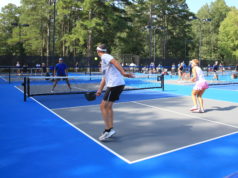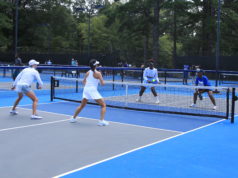By Page Love, RDN, CSSD, USPTA and Hailey Macke, Dietetic Intern
The holidays do not need to be a time of being completely being off track with your performance eating plan. In fact, many holiday foods can fit right in and are full of nutrients that will enhance your performance as well as provide lots of antioxidant nutrition. With a few modifications, you can convert your traditional rich recipes into low-fat, high-fiber, high-energy sport nutrition choices. Let this holiday season be a time of peaking with your sports nutrition!
Here are a few tips to keep in mind as you approach this calorie-laden time of year!
- With a mindful approach, you can modify choices and stay very much on track and avoid gaining that holiday weight.
- Try to eat all of your regular meals, ideally, breakfast and lunch even before an evening celebration so that you do not arrive too hungry and overindulge.
- It is fine to save up a little, such as eating lower fat before the larger holiday meal, but try not to miss the key food groups or protein and grain that stabilize your blood sugar levels and help control cravings.
- Stay hydrated during the day, especially if you plan to have any alcoholic beverages in the evening.
- Be moderate with alcohol: one drink vs two, choosing hydrating mixers like seltzer or diet decaffeinated soda; and try to alternate alcoholic beverages with water and low-calorie drinks.
- Even if you feel like you have overdone it, try to get right back on track the next day. Don’t skip your breakfast either because this will only continue the cycle of extreme hunger followed by over eating.
Here are some simple recipe modifications that can make those holiday recipes sport nutritionized!
- Turkey: Try injecting fat-free chicken broth instead of butter. Also explore more herbs (with sprigs of sage, oregano, thyme, rosemary) and aromatics (onion, apple, lemon, orange) instead of fats and oils for flavor. Focus on eating more of the white vs the dark meat; the dark meat is higher in fat and cholesterol.
- Stuffing: Consider using a higher fiber bread or use 1 ½ cups brown rice with chicken sausage and veggies. Cook the rice in low-fat chicken or vegetable broth.
- Other protein options: Consider high omega 3 fish, such as salmon, to receive more anti-inflammatory benefits. A quinoa and salmon salad is a colorful addition to the holidays! For this recipe go to delicious.com.au/recipes/quinoa-salmon-super-salad/0Lf1BPJj
- Sweet potato casserole: Instead of the traditional marshmallow, you can do an oatmeal topping consisting of almond meal, oats, coconut sugar, vanilla, cinnamon, and pecan halves. All these changes will increase fiber and antioxidants and lower sugar and fat.
- Brussel sprouts: Drizzle with olive oil, salt and pepper, and roast in your oven for 30 minutes. You also can do a lemon parmesan seasoning. It’s a great way to add another anti-inflammatory vegetable.
- Green Bean Casserole: Instead of canned soup, 2% Greek yogurt can be used with various spices and mushrooms to increase antioxidants (more veggies) and even boost the calcium content for bone health!
- Mashed Potatoes: You can use Greek yogurt and change to 2% milk for lower fat content and higher protein with same creamy result. Again, another way to increase bone- and muscle-building nutrients!
- Cranberry Sauce: Lower the sugar by sweetening with honey or maple syrup instead. These are natural inflammation fighting foods. Remember, “eat red” with your produce choices to lower your muscle and joint inflammation.
- Pumpkin Pie: Add a scoop of vanilla or protein to the pumpkin pie filling and use whole-wheat flour for the crust.
- Apple Pie: Whole-wheat flour can be used for the crust with light whipped butter, nonfat milk, and maple syrup can replace sugar in your filling.
Page Love is an avid ALTA participant and sport dietitian/nutrition advisor for the WTA and ATP professional tours and serves on the USTA sport science commission and has a private practice in Atlanta. You can reach her at nutrifitga.com. Hailey Macke is a current student athlete at Life University and plans to become a sport dietitian in the future!




